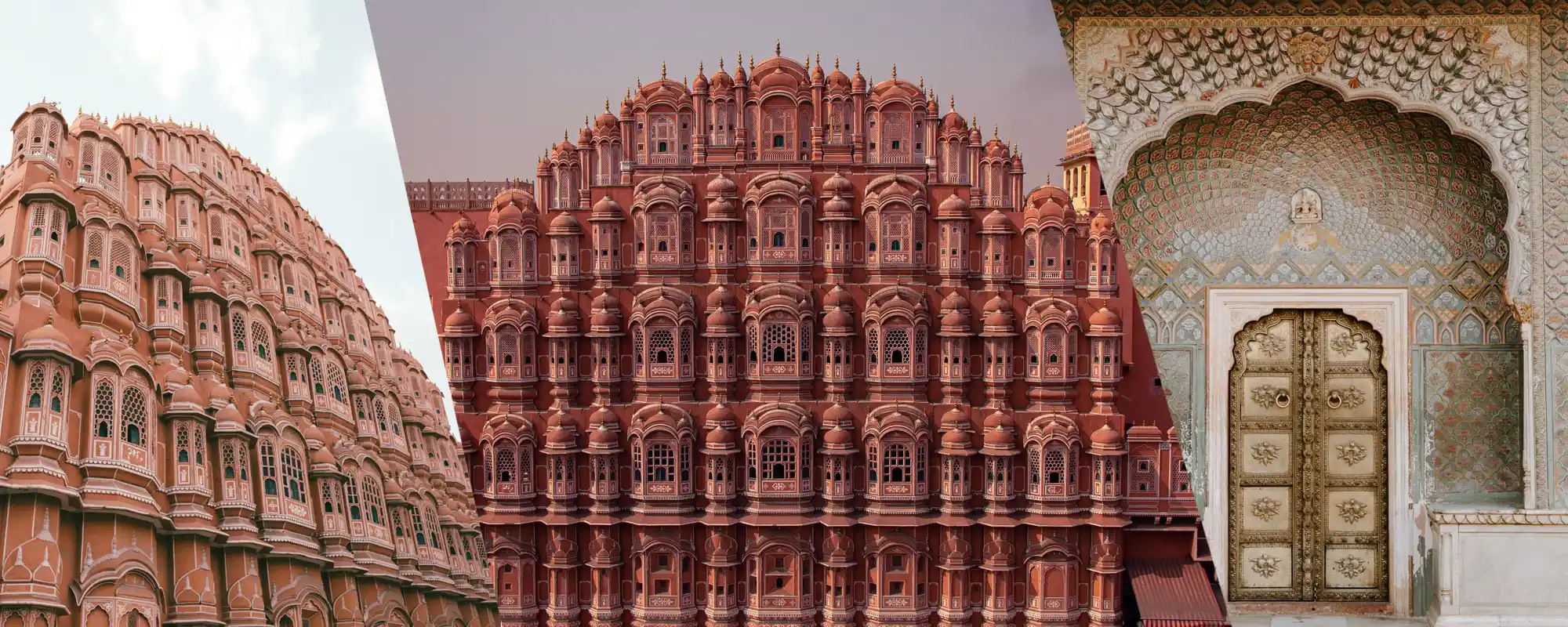
The magnificent and iconic structure of the Pink City Jaipur, Hawa Mahal is one of the majestic looking attractions of the city and stands tall in the city intersection at Hawa Mahal Road at Badi Chaupad. Built by Maharaja Sawai Pratap Singh in 1799, the five-storey building resembles a honeycomb of a beehive and derives its name from its unique structure, which is a mesh of numerous small windows or ‘jharokhas’. Hawa Mahal translates to ‘Palace of Winds’ owing to these numerous windows which offer ventilation and keeps the palace comfortable during summers.
The main purpose of building Hawa Mahal was to allow the women of the royal family and the court to witness the busy streets of the Johari Bazaar and the festivities from the many jharokhas of the palace, without being seen themselves as it was the custom in those times. Made of red and pink sandstone in a pyramidal structure which makes it looks like a crown, Hawa Mahal is the tallest building in the world that has been built without a foundation.
It is also said that the Hawa Mahal is dedicated to Lord Krishna as the architecture of the edifice resembles the crown of Krishna which makes it even more popular and close to heart amongst the visitors. Hawa Mahal is adorned with 953 tiny windows, also kown as ‘jharokhas’, which are embellished with beautiful latticework. It is a specimen of the cultural and architectural wonder that depicts the true unification of the Hindu Rajput and Islamic Mughal architectural styles. The Rajputana style can be witnessed in dome canopies and fluted pillars while the Mughal style of design can be seen depicted in stone inlay filigree work and the arches. A stunning view of the city and other major attractions nearby can be seen from the top of the palace which is a visually exquisite sight to behold.
Hawa Mahal was built by Maharaja Sawai Pratap Singh in 1799, the grandson of the great Maharaja Sawai Jai Singh who established Jaipur. He was utterly impressed by the Khetri Mahal constructed by Maharaja Bhopal Singh in the town of Jhunjhuna in Rajasthan, that he ordered to built something as splendid which today stands as a glorious landmark of the city.
Hawa Mahal was built as an extension of the City Palace that leads right to the ‘zenana’ or women’s chambers. One other reason to build this majestic monument decorated with fine lattice windows, screened balconies, and arches was to facilitate the royal women, who otherwise used to follow the Purdah system that restrained them from appearing in public, to get a glimpse of the festivities, royal processions, and market shenanigans on the streets. Through this way they could enjoy their freedom without breaking the system.

Hawa Mahal was designed by the genius architect Lal Chand Ustad and designed it keeping in mind the architectural styles of both Rajputana and Mughal architecture. It stands with a height of 15 meter (50 feet) from the ground and is the tallest building to be made without a foundation. Owing to the lack of foundation, the structure of Hawa Mahal is tilted at an angle of 87 degrees and is made in a pyramidal style which has made it stand tall for centuries.
Keeping in line with the ‘Pink City’ attractions, the monument was built with red and pink sandstones and has 953 elaborately carved windows (jharokhas), some of which are made of wood. The jharokhas are made in a way that air circulates naturally through them, thus air conditioning the entire structure in the scorching summers. Each jharokha has a chamber in which one can sit and view the street. Maharaja’s devotion of Lord Krishna can be seen in the design of the structure as it resembles the crown of the lord. The exterior of the monument with small windows, intricately and beautifully carved motifs is akin to that of the honeycomb of a beehive which gives it a unique appearance.
Inside Hawa Mahal : The brilliant design and the exquisite beauty of the palace made it the favorite resort of Maharaja Jai Singh. The entrance to Hawa Mahal is through an imperial and royal door from the City Palace where three two-storied buildings can be seen surrounding a large courtyard with Hawa Mahal on the eastern side. The courtyard currently has an archaeological museum housing relic. The inside of the Hawa Mahal is comparatively plain and simple from that of the exterior with chambers also acting as passages and pillars leading to top storey. The width of the top three storeys is that of a single room while the first two storeys have courtyards. The rooms are adorned with colorful medleys of glasses, patterned stonework, and ‘chhatris’ which are elements of Rajput style architecture. There are no staircases inside the structure and the top storeys can only be reached through ramps.
Hawa Mahal is a central point of the city where several shops and street markets are established right outside the palace with an assortment of things to buy. The expansive shopping area is known as Badi Chaupal or Manek Chowk and is daily flooded with tourists and shopaholics from across the world. Things such as traditional clothing, jewelry, Jaipur vase, traditional clay earthenware, traditional footwear called ‘jutis’, Jaipur style dress material, handicraft, and many other things can be bought here.
Several stalls of street food selling rich delicacies of Rajasthan also line the market and the aroma from it wafts the entire area making it impossible to ignore the delicious smell. Some cafés are also there opposite Hawa Mahal which gives a great view of the grandeur while you sip in your favorite coffee or tea.
Timings – Hawa Mahal can be visited on all days from 9:30am to 4:30pm
Entry Fees – INR 50 for Indians, and INR 200 for foreigners
By Air: Jaipur airport is 12.2km from Hawa Mahal from where a taxi can be hired to reach the palace directly.
By Train: The nearest Jaipur Junction railway is 3km from Hawa Mahal from where rickshaw will be easily available. There is also a metro station called Jaipur Ajmeri Gate at 1km away.
By Road: Jaipur is connected to other neighboring cities and states via state buses. From ISBT, you can take a rickshaw or a local bus to reach Hawa Mahal.

The austere-grandeur of Hawa Mahal is something that cannot be missed by any. Located in Jaipur, Hawa Mahal was built by Maharaja Sawai Pratap Singh in 1799 and is called such because of the mesh of several small windows in its unique structure. The unique design of the monument allowed the women of the palace to see the festivities of the streets without coming outside and to have ventilation in hot summers.
Hawa Mahal was built by Maharaja Sawai Pratap Singh in 1799.
Hawa Mahal is 50 feet tall structure.
Yes, you can go inside Hawa Mahal although the glory of the structure is from outside as it is quite plain and simple from the inside.
Jaipur has several attractions made from red and pink sandstones and the city was paintes in that color to welcome Queen Victoria’s husband, Prince Albert in 1876.
Copyright 2012-2022 Indiamap Digital Pvt Ltd. All rights reserved. Privacy Policy | Terms of Use